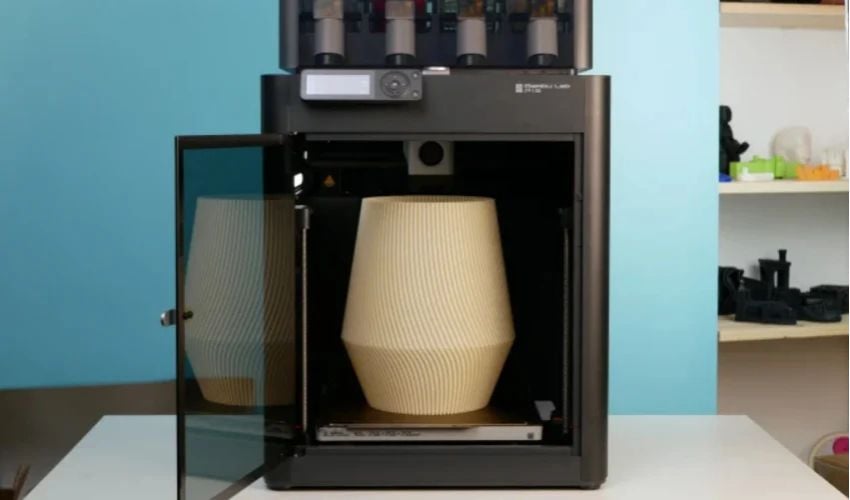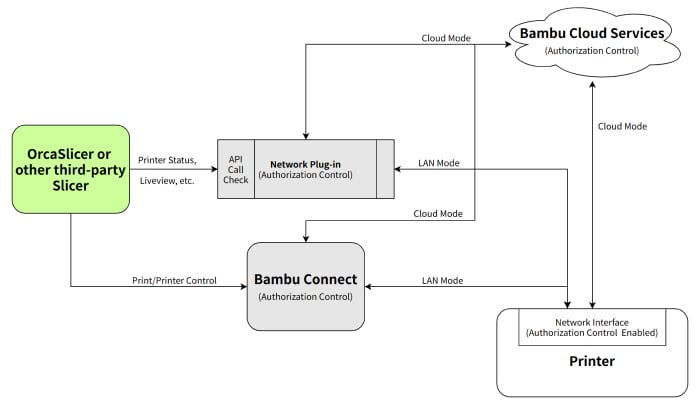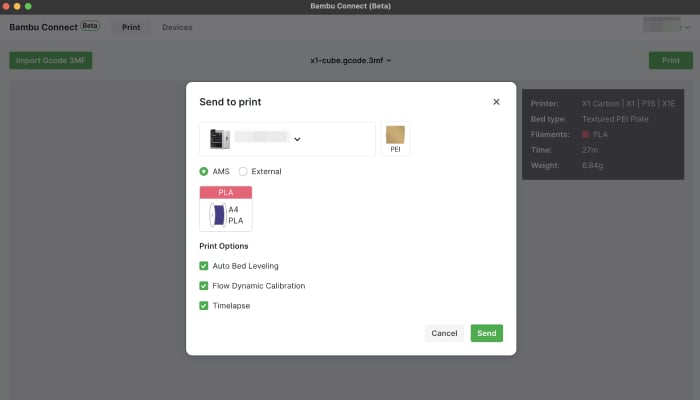Bambu Lab at the Heart of Controversy: An Update that Divides the User Community

Since its launch, Bambu Lab has rapidly established itself in the 3D printing market, thanks in particular to printers such as the P1S, renowned for their speed, reliability and ease of use. However, recent changes in the firmware of these devices have prompted a strong reaction from the user community.
Last week, Bambu Lab announced an update to its firmware. The response, far from unanimous, has sparked a lively debate within the 3D printing community. While the manufacturer points to enhanced security measures, many users see the changes as an attack on the principles of openness that have characterized the 3D printing ecosystem since its inception.

Bambu Lab has notified users of the update via a blog post (Photo credit: Bambu Lab).
The Restrictions that Divide
Following the firmware update introduced by Bambu Lab, users must now use a cloud application to configure their devices. This reliance on the cloud has been criticized as going against the philosophy of total control over tools, dear to the maker community.
In addition, the update introduced restrictions on local access to printers. Although a “developer mode” feature has been added in response to community criticism, it still requires the use of the cloud application to initialize the printer.
An Update in the Name of Security
According to Bambu Lab, the new measures introduced by the firmware were designed to address critical security issues. The company claims to have recorded up to 30 million unauthorized requests per day to its servers, accompanied by targeted cyberattacks, including distributed denial of service (DDoS) attacks. To counter these threats, the firmware incorporates authorization and authentication mechanisms for several key printer functions, such as:
- Linking and disassociating printers with user accounts;
- Access to live video for remote print monitoring;
- Firmware updates;
- Launch print jobs via cloud or LAN mode;
- Control of critical parameters, such as temperatures, calibrations and printer movements.

Bambu Lab explains the new workflow following the update with a graphic (Photo credit: Bambu Lab).
These improvements also include end-to-end encryption protocols and code signing to guarantee the integrity of updates. However, these justifications are not enough to appease a community historically attached to autonomy and open source.
The Community Reacts: Innovation Versus Restrictions
The update immediately sparked criticism in forums, online groups and social networks related to 3D printing and the manufacturer in particular. Users’ main concerns cluster around four axes:
1. A move away from open-source principles
Since the RepRap project, among others, 3D printing has thrived on a philosophy of openness and sharing. Manufacturers, software developers and users have relied on open ecosystems to innovate. By introducing authorization mechanisms and restricting the use of certain protocols, Bambu Lab seems to be moving away from these principles, which are perceived as going against certain market values.
2. Limited compatibility with third-party software
The new security measures include restrictions on operations carried out via third-party software. This worries some users who prefer to use alternative slicers or specific control solutions, such as Orca Slicer or Panda Touch. While Bambu Lab says it is working with third-party developers to ensure continued compatibility, these statements have not been enough to ease tensions.
3. Privacy and remote control concerns
Some users fear that the new functions will introduce risks in terms of personal data collection. The idea that a printer could potentially be remotely controlled by the company, even under the pretext of a security update, fuels mistrust.
4. Towards a closed ecosystem?
Concerns about vendor lock-in are recurrent. With this update, Bambu Lab is accused of promoting the exclusive use of its products and services, thus limiting interoperability with other hardware.

Bambu Lab Connect lets you start printing and manage your 3D printer farm. (Photo credit: Bambu Lab)
An Answer that Fails to Convince
Faced with the wave of criticism, Bambu Lab tried to ease tensions by introducing adjustments and announcing changes:
- Developer mode: To meet the needs of users wishing to preserve the openness of their system, the company has announced a “developer mode.” This will allow the use of older network protocols (MQTT, for example), facilitating integration with third-party tools.
- Clarification on LAN mode: Bambu Lab reminds us that LAN mode, which requires neither an Internet connection nor a user account, remains available for those who wish to avoid the cloud.
- Denial of rumors: The company firmly denied accusations of remote disabling of printers. It has also rejected allegations that it restricts the use of third-party filaments.
Despite these efforts and the popularity of Bambu Lab printers, some users remain skeptical. In particular, they point to a clause in Bambu Lab’s terms of use, according to which a printer could block new prints until the firmware is updated, rendering it unusable without an update. This ambiguity continues to fuel concern.
This controversy could encourage users to turn to alternatives such as Creality, Anycubic or Elegoo, which offer low-cost printers, or Prusa, known for its commitment to open source.

Users express their dissatisfaction on Bambu Lab’s Reddit page.
A Turning Point for the 3D Printing Industry?
This conflict highlights a growing tension in the 3D printing industry: the search for a balance between innovation, corporate control and user freedom. As 3D printers become increasingly connected and sophisticated, the risks of cyberattacks are growing. But must the solutions proposed by manufacturers necessarily involve restricting users’ freedom?
This situation is reminiscent of another landmark controversy: that of MakerBot, which, after pioneering open-source 3D printing, chose to shut down its ecosystem in 2012. This strategic about-turn sparked strong indignation within the community and contributed to a decline in confidence in the brand. While this decision was aimed at better protecting its intellectual property and guaranteeing a controlled user experience, it also marked a turning point in the perception of MakerBot, long celebrated for its role in the open-source movement.
In an industry where innovation often relies on open collaboration, Bambu Lab’s decisions may well serve as a lesson, or a warning, for other manufacturers. Time will tell whether these strategic choices will enable Bambu Lab to strengthen security without alienating its community, or whether they will mark the beginning of a lasting loss of confidence in the brand.

Bambu Lab’s developer mode should make it possible to retain previously available functions and limit dependence on the cloud.
For now, the community is awaiting concrete gestures from Bambu Lab to restore confidence. Otherwise, the question in some people’s minds is, could the company lose its position in a highly competitive market?
What do you think of Bambu Lab’s new update? Let us know in a comment below or on our LinkedIn, Facebook, and Twitter pages! Don’t forget to sign up for our free weekly Newsletter here, the latest 3D printing news straight to your inbox! You can also find all our videos on our YouTube channel.







I purchased an X1C in December. Had I known of this situation I would have chosen the other brand. I’m a bit suspicious by nature and this feels like Big Corp poking around in my business.
Hi. I’ve heard similar remarks from others but I’m curious, what other brand would you have chosen?
The “other” brand and model is the Creality K2 Plus, which is a plus-sized X1C clone that has a CFS which is an outright copy of the Bambu Labs AMS with some product improvements.
The K2 Plus is a major step up from the commodity series of Creality printers such as those on the Ender label. It’s got its share of quirky little omissions such as the inability to print with less than 0.2mm layer height in multi-color / multi-filament mode, and extremely buggy software — especially if you use Mac OS.
Looks like I’m choosing the other brand now. Shame they pull this stunt after lighting the industry on fire and leading with so many innovations while making this affordable for all. Looks like a trend in using open source to make them a bit then abandoning it like a dirty towel. Shame on you Bambu
I bought an A1 and AMS in December as part of the Black Friday. This happening so quick after screams of bait and switch where core parts of the use of the printer will change seemingly overnight. I’m still on the original firmware as I didn’t want to update the firmware during the initial set up which I feel may have saved me a bit of a headache…
I’ve so far put 4 other people off Bambu printers who asked me how mine is going one an x1 who had it in their basket! I just tell them “it’s going fine, but don’t buy one if you need/want to try using third party slicers. Or don’t want to potentially get locked into their filament in future, we’ve no idea what they may change down the line because this newest firmware is so crippling…” which they all immediately turn their nose up at.
The user community is not divided, it’s wholy against the update. I was eyeing their printers as my first device, but will absolutely choose any other brand over BambuLab now. Devices bought should be devices owned, period.
I bought a P1S just before Christmas since everything I read indicated that Bambu was the easiest printer to use. I am using this only for home use and so far I agree that it is very easy to use. It’s disturbing however to read about the backlash with the firmware update. I hope Bambu can resolve user concerns.
What’s the big deal?
I use the X1E with Bambu Studio and am fine with it. I feel no need to go to another slicer with Octoprint. Really, why do I want to have to screw around with setting up a Linux server on a Raspberry Pi just to gain remote control and monitoring when I can just download a Bambu Handy app that does all that stuff via my mobile phone.
The worry that Bambu is going to lock users down to only their filament is just “sky is falling” nonsense. What Bambu Lab will deep six is using apps to clone their RFID tags to work with 3rd party filaments. Really. How hard is it to fat finger in your generic filament ID and profile? Also, if you really got to use RFID for filament ID on your 3rd party stuff, just pull the RFID tag from a spent spool of Bambu Lab filament (providing it is the same type and color) and stick it on the hub of your empty spool before re-winding the generic filament on to it. Done and done.
As for MQTT and FTP, Bambu Lab has said they will not be blocking these protocols. So, you can still use FTP on your LAN to move files to the 1.5 TB micro-SD card on your X1, and your BL LED by Dutch Developer will still be able to read X1 machine states and switch on and off LEDs or change their colors to match those states. Same, for Home Assistant — you can still use it to read states reported by the X1 and then have it open your garage door and turn on your toaster oven when you open your printer door.
Thousands of users do the BL LED enhancement to their X1s. Do they even know that configuring that thing and its connection to their X1 is done via a cloud io called Github — and that it uses an MQTT broker that is remote from your network and printer on some cloud server out there? That cloud server has your connection access codes to not only your LAN or WLAN but also your X1. And, if that cloud server goes down or you can’t connect to it via the Internet, your fancy, stateful LEDs are suddenly going to not work. That’s no different than having to rely on a Bambu Cloud Connect., which is a web broker.
What will get killed is the X1 Plus non-OEM firmware. Personally, I’m not a fan of jailbreaking OEM firmware. 9.999 persons out of 10 will just wreck their system poking around with erasing the stock firmware and flashing in something else. If Bambu offers APIs for developers to plug in to, then let’s see how these APIs are before complaining.
About the only thing I can see worth complaining about is why Bambu Lab hasn’t simply adopted standard, security tokens as a means for developing secure handshakes with outboard apps and devices.
The people who really have something to worry about are New Yorkers. Their state legislators are pushing forward a bill that will require a criminal background check for anyone wanting to buy a 3D printer.
Didn’t mean to post my reply in response to you, AL. This was supposed to be a new response thread. Sorry about that.
thank you. this is the only comment here not rushing to jump to a conclusion about a hypothetical future. People need to calm down. Bamboo wants to sell printers as well. If they put everything on a subscription model who’s gonna buy bamboo printers with alternatives around?
The problem is Bambi claims it’s for user security and safely but prior to the firmware upgrade and cloud authorization there were about zero hacks on users (people with Bambu printers). Now Bambu has said THEY get 30 million hits a day on their servers- so the problem is on their end which doesn’t affect users. So all this talk about our safety and security is BS. Bambu also tried to gaslight users and lied about softfever working with them on their orca slicer. Btw orca slicer just put out they do not recommend anyone do their firmware upgrade/Bambu authorization. Then there is Bambu removing their website and blogs from internet archive sites to cover there arses.
I was going to buy the Bambu A1 then their new H2D printer but not now. By introducing Bambu connect users are now at risk from the 30 million hits a day that Bambu claimed. I see Bambu adding subscription fees and not allowing people to use the machines they bought to their fullest capacity. Bambu has said they are working on print farm software with subscription fees and I expect they will have a fee for their verified print files and more down the road.
Yes you can choose to not upgrade but all new machines will require it. Hmmm…
So yea I’m not getting Bambu and now looking at Creality K2 plus, QIDI 4 and the Prusa Core One or their XL.
> By introducing Bambu connect users are now at risk from the 30 million hits a day that Bambu claimed
No, this doesn’t make any sense.
And regarding subscriptions: https://www.theverge.com/2025/1/21/24349031/bambu-3d-printer-update-authentication-filament-subscription-lock-answers
> By introducing Bambu connect users are now at risk from the 30 million hits a day that Bambu claimed
No, this doesn’t make any sense.
And subscriptions aren’t gonna happen either: https://www.theverge.com/2025/1/21/24349031/bambu-3d-printer-update-authentication-filament-subscription-lock-answers
I don’t care, I wanted the “Apple” of 3D printers, and got it. Shit just works, and I don’t care to use any 3rd party anything on the P1S.
I just bought mine 6 months ago. Now I would I had gone with a competitor
Wow, I was just inquiring about this brand and was thoroughly impressed with the videos I watched. I was considering upgrading from my Anycubic Mega but, I think I’ll be looking at Creality… Another impressive printer (without restrictions).
I could be wrong. On the surface, the Bamboo change seems harmless however, it does make me think about the possibility of I.P. fishing. Again, I could be wrong.
Regarding the Bambu Lab Controversy:
Having spent the past few years using ANYCUBIC hardware, I have been in the process of researching new equipment. I have been gravitating towards the Bambu Labs P1P, P1S and X1C printers. After initial basic research of specs and a few trusted online reviews, it was narrowed down to either the P1S/AMR Combo or the X1C Combo. Of course, there is discussion over whether the extra 500 USD/GBP was worth the upgrade for the X1C, and online reviews made good arguments for both. Especially as yes, one could upgrade the Hot end and extruder gears for a minimal fee, enabling the use of harder materials. However, it boils down to whether or not the faster processor, better camera w/LIDAR (providing the AI assisted print failure) and also the improved print bed temp. I really couldn’t be swayed either way, but the question of budget not being as important as maybe other consumers; I settled on the X1C Combo.
One of the YouTube reviews that I saw; I must not have been concentrating on enough, as they mentioned the Firmware update in question. I must say, that now I know the true extent of what Bambu Labs have done; I have completely abandoned my intention to make my purchase, which is in good time. I have experienced a lucky escape as I was a day or so from making my order. I can only echo the concerns of the side of the 3D printing community that are worried about the changes. I think that I have had a lucky escape.
I personally think that Bambu Labs could have sealed their fate and lose consumer trust.
Nobody mentioned that Makerbot was started using open source hardware and software designed and developed by an English university.